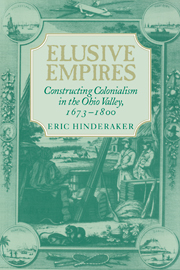Book contents
- Frontmatter
- Contents
- Maps and Figures
- Preface
- Elusive Empires
- PART ONE EMPIRES OF COMMERCE
- PART TWO EMPIRES OF LAND
- Map 1 Early occupation, 1673–1731
- Map 2 Trade and dispersal, 1732–1765
- Map 3 War and dislocation, 1766–1783
- Map 4 Displacement and removal, 1784–1800
- 3 Definitions of Value
- 4 The Alchemy of Property
- Coda: The Ohio Valley on the Eve of the Revolution
- PART THREE EMPIRE OF LIBERTY
- Epilogue: State Power and Popular Authority in the New American Nation
- Bibliography of Cited Materials
- Index
4 - The Alchemy of Property
Published online by Cambridge University Press: 16 February 2010
- Frontmatter
- Contents
- Maps and Figures
- Preface
- Elusive Empires
- PART ONE EMPIRES OF COMMERCE
- PART TWO EMPIRES OF LAND
- Map 1 Early occupation, 1673–1731
- Map 2 Trade and dispersal, 1732–1765
- Map 3 War and dislocation, 1766–1783
- Map 4 Displacement and removal, 1784–1800
- 3 Definitions of Value
- 4 The Alchemy of Property
- Coda: The Ohio Valley on the Eve of the Revolution
- PART THREE EMPIRE OF LIBERTY
- Epilogue: State Power and Popular Authority in the New American Nation
- Bibliography of Cited Materials
- Index
Summary
After the middle of the 18th century, Indian relations in the British empire were increasingly strained unbearable pressures – pressures generated by the alchemy of property in British America. That alchemy worked according to a simple calculus: as population grew, so did demand for land; as demand for land grew, so did its value; as its value grew, efforts to capture and control it became more aggressive, more frenzied, more grandiose. Land hunger was not a new phenomenon in the British colonies – it was, in fact, one of the most persistent patterns of the colonial era – but in the early eighteenth century, not only in Pennsylvania but throughout the colonies, British and Indian leaders established increasingly effective diplomatic means for resolving conflicts over land. The attempt to extend Britain's territorial empire into the Ohio Valley, which originated about 1750, overreached existing structures of diplomacy and required new agreements with the Indians of the Ohio Valley – Indians who had already been dispossessed once, many thought unjustly, of their lands.
These pressures burst into the open in the Seven Years’ War. As France and Britain sought to control the Ohio Valley, the Ohio Indians looked for a way to maintain their autonomy and power, an effort that shaped both their wartime alliances and their postwar initiatives. Britain's victory placed enormous new administrative demands on the empire; to succeed in managing affairs in the Ohio Valley, its agents needed far-sighted policies and cooperative, influential Indian leaders.
- Type
- Chapter
- Information
- Elusive EmpiresConstructing Colonialism in the Ohio Valley, 1673–1800, pp. 134 - 175Publisher: Cambridge University PressPrint publication year: 1997



